Mr. S. Morton Vose Letter
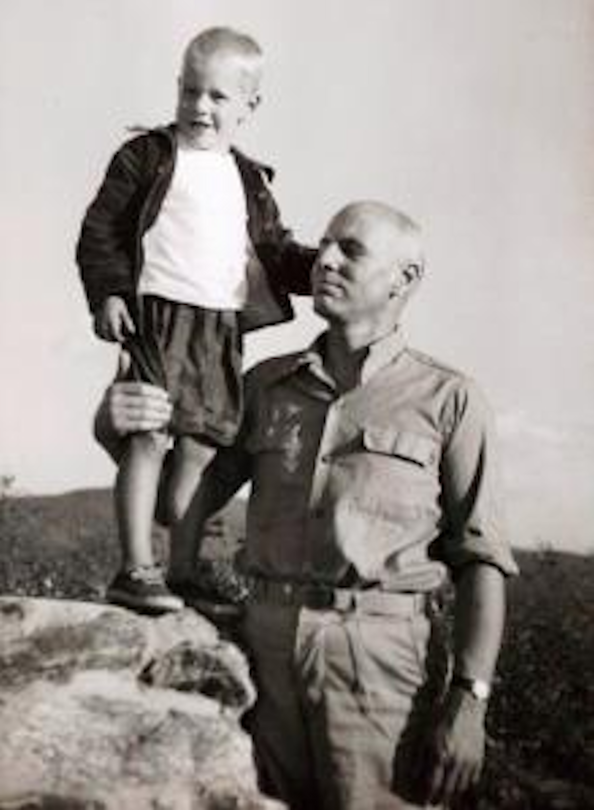
 Seth Morton Vose II with son
Seth Morton Vose II with son
INTRODUCTION
In the school year of 1969-70 the Deerfield Academy's American Studies Group chose Woodward as its project. The purpose of the group's project was to compile a complete catalogue of Woodward's work. The group, led by senior Garrett Hack, began a letter writing campaign to museums, galleries and libraries across the country. Using Woodward's cousin Florence Haeberle, his close friend F. Earl Williams and long time employee and beneficiary Dr. Mark Purinton as primary resources, the group began collecting names of local people believed to be in possession of paintings and drawings for a year-end exhibition held at Deerfield's Hilson Gallery as well as for catalogue purposes. In letters to prospective owners, Hack and faculty advisor Robert Merriman, asked for (1) confirmation of ownership, (2) any and all information related to the work, (3) to share the names of any other owners they knew of and (4) to provide any rememberance or recollection of Woodward himself. Of all the people who responded to the letter campaign, most deferred any recollections of Woodward to the aforementioned three of Haeberle, Williams and Purinton, with a couple of exceptions. Mr. S. Morton Vose, director of the Vose Galleries in Boston from 1927 to 1978 was one of those exceptions.
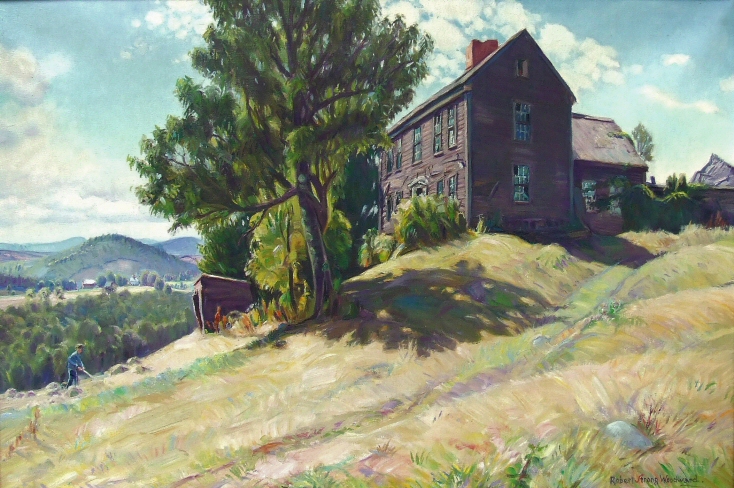
 New England Essence sold by Vose in Atanta
New England Essence sold by Vose in Atanta
The Vose Galleries (est. 1841) on Boyleston Street in Boston began representing Woodward in January of 1936 according to RSW's records and would for the remander of his career. They
served him very well, particularly in collaboration with museums around the country, such as, the High Museum in Atlanta, GA and the Dallas (TX) Museum of Fine Arts. But perhaps the most
interesting exhibition was the Spingville (UT) International Exhibition of Art of which RSW participated for nearly 15 years. Mr. Vose's two stories are simply priceless...
BCM
Letter from S. Morton Vose II to Garrett Hack:
December 1, 1969
Mr. Garrett E. Hack, Chairman
The American Studies Group
Deerfield Academy
Deerfield, Massachusetts 01342
Dear Mr. Hack:
I planned to send you a photograph of the Robert Strong Woodward painting which I mentioned but to date have not obtained one. I have thought we had already photographed it when I last wrote you. The
painting measures 24 x 36, and is entitled "New England Essence." The price we must ask is $1,500. I presume that it was
painted in the vicinity of Mr. Woodward's home in Buckland.
"I never could
quite understand
why he could not
have explained the
situation to the women."
When I knew him, Robert Strong Woodward was, of course, confined to a wheelchair, but he was a vigorous, rugged appearing man with rather high coloring. You are, of course, aware that he had an automobile which was driven for him by and attendant, and was equipped with an easel attached to the door or windshield so he can paint while sitting in the car. He told me that earlier in his painting days he used to drive a buckboard with a team of 2 horses, having himself strapped into the seat and going off across the fields in this manner alone. At one time he was returning from such a foray and approached a small railroad line just as a steam engine was approaching. As the engine passed, one of the horses was alarmed and tossed its head, jerking the reins from his hand. The horse did not bolt, but of course he was unable to retrieve the reins and so sat there for a considerable time. Eventually two women, apparently summer visitors to the area, passed by on a stroll, and he asked if one of them would hand him the reins. The reply was that they were not in the habit of doing such things for an able-bodied man, and they went on with their walk. It was sometime later before he was eventually helped out of this predicament. I never could quite understand why he could not have explained the situation to the women.
I am sure the you know, too, that his paralysis occurred when, as a student at college in California (I believe it was Leland Stanford) he and a friend were prospecting in the desert. He carried a pistol (loaded) in his jacket pocket, and on becoming warm, took it off and threw it on the ground. The gun went off, severing his spinal cord.
Wishing you the best of luck with your project,
S. Morton Voss, II
SMV:eo
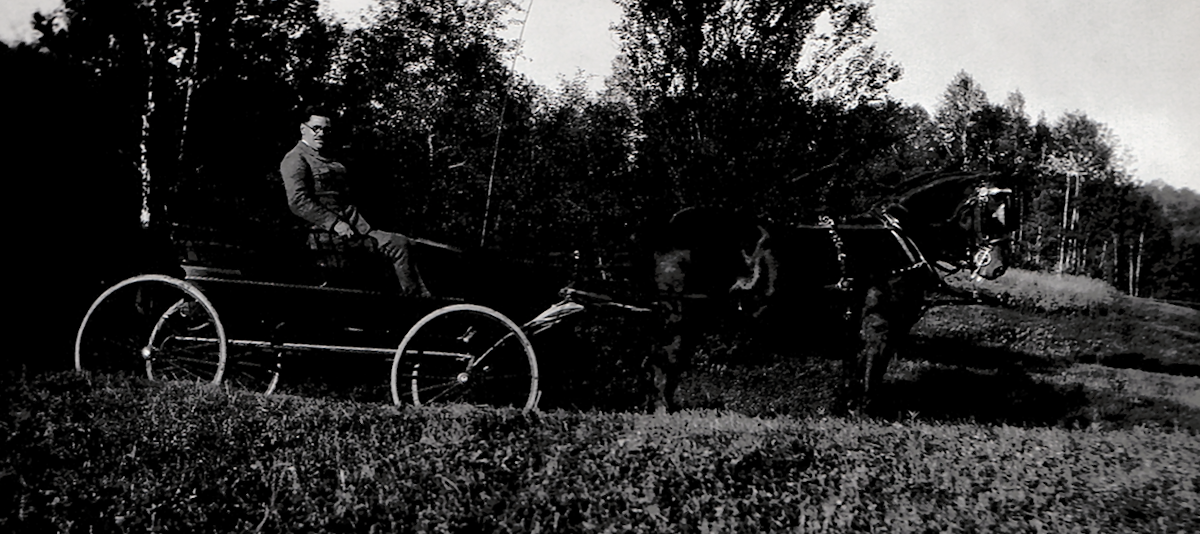
 In what may be one of our finest strokes of good luck... we find a negative
In what may be one of our finest strokes of good luck... we find a negative
COMMENTARY
I could not help but to laugh out loud after reading this letter from Mr. Vose. His description of RSW as appearing "vigorous and rugged" was often used to describe him in numerous articles throughout his career. Vose's remark about "high coloring" could be taken to mean that he had the coloring of an outdoor's man, flush with color. However, the two brief stories he shares with us are really the prize of this letter.
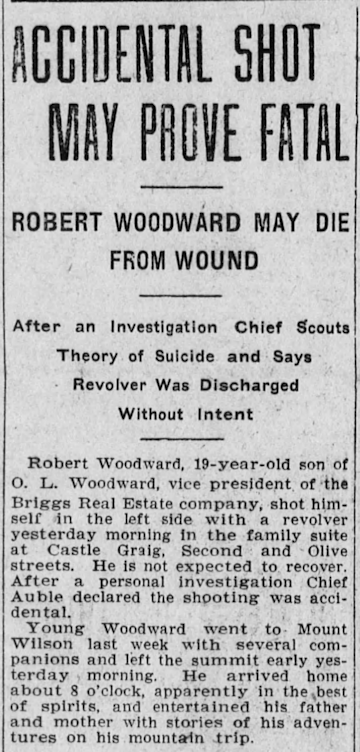
 September 4, 1906 LA Herald report
September 4, 1906 LA Herald report
The first story of RSW being stranded at the rail tracks after his horse got slightly spooked by the passing engine is very telling of two facets to his personality. One being his sense of humour, the other is the self-consciousness he experienced regarding his paralysis. Woodward was known to have a wonderful sense of humour and sharing this story with Vose must have garnered quite a laugh. Even so, Vose was left perplexed as to why Woodward did not correct the women and explain his condition. The simple answer is that he never liked to draw attention to his paralysis. It would simply be uncharacteristic of him. Furthermore, as discussed above, for all intents and purposes, he presented himself as able-bodied and the women's response most likely amused him to no end. Woodward was very sensitive to how he was perceived, and the fact that the women saw him as perfectly able to help himself, kind of cornered him into not correcting them.
The second account of his accident is a bit more complex. As already discussed, RSW did not like to draw any attention to his paralysis, and he certainly did not like talking about it. Also, as we all know, curiosity gets the better of us, and RSW was most likely frequently asked for details of the accident itself. He never wanted to discuss it, in fact, not even his closest of friends knew the whole story. His close friend, F. Earl Williams, in his telling of the story doesn't even get it right. Williams always says the injury was to RSW's hip! RSW wanted to be regarded on the merit of his abilities, so Vose's recounting of the story demonstrates not only his appreciation for the absurd but his desire to keep its details private. It seems that when necessary Woodward used people's own fancy to tell a story that would be suitable and never discussed again. (Today we would call it 'controlling the narrative'). Throughout his career, RSW either allowed or perpetuated a myth that seemed to satisfy everyone's curiosity without revealing too much of the truth. He simply did not
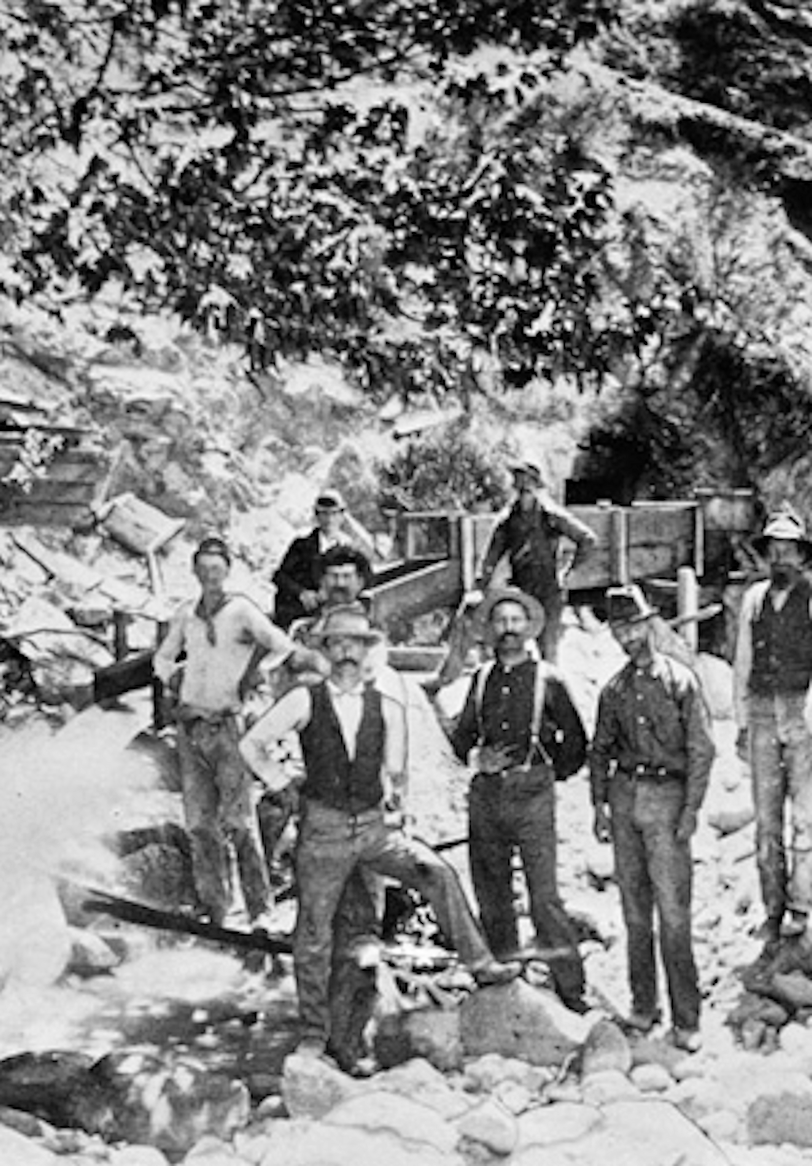
 A photograph of a miners diverting
A photograph of a miners diverting
water while prospecting near Corvina 1885.
The telling of the story closest to the truth is given by his close friend Lawrence Lunt who wrote the story to be shared after his passing (on the account, he was
a physiatrist and probably counseled RSW during his life) and is confirmed by original newspaper clippings. I encourage you to read it, but for our purposes here I will tell you that RSW was in Los
Angeles at the time of his accident. He and several friends had just arrived back to RSW's parents hotel suite from a weekend of camping on the morning of Labor Day. What has never been
confirmed is whether he ever attended Stanford. We are currently working on this but as of today, there is no confirmation he was enrolled at Stanford at the time. The year was 1906, the year of
the San Francisco earthquake and records are kind of hard to come by but IF he was enrolled, he only attended Stanford for 11 days!
BCM August 2018
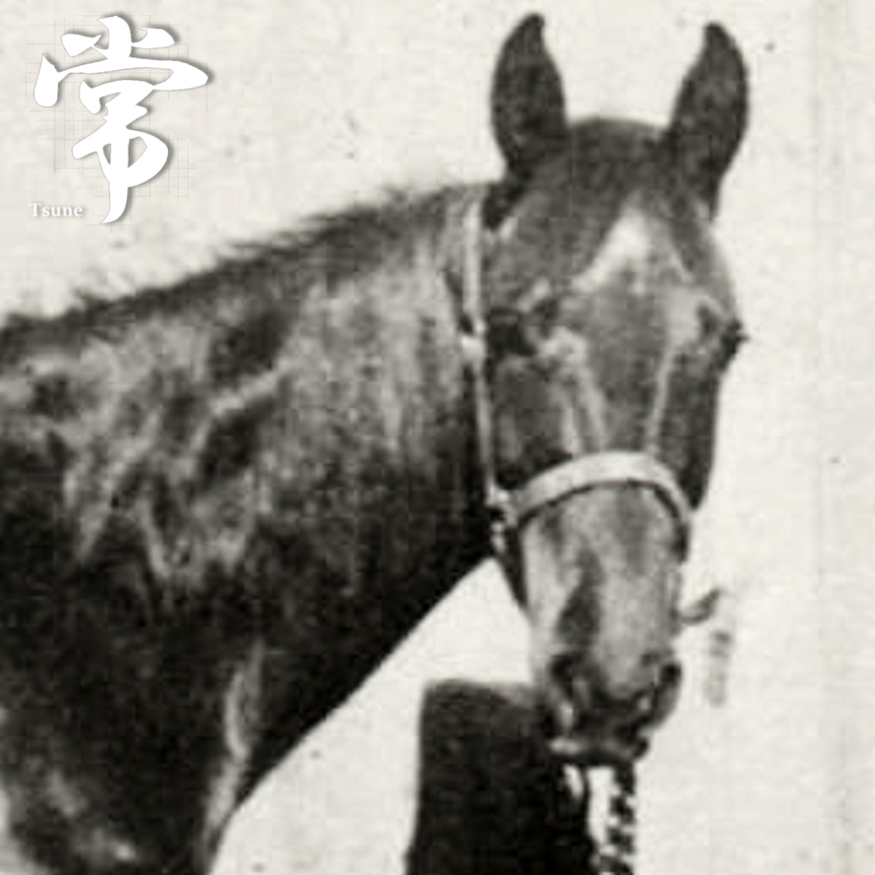
 The "other" horse Tsune and the
The "other" horse Tsune and the
Japanese Kinja character.
ADDENDUM, JULY 2020:
When this page was originally created there was no evidence Woodward had a two-horse pulled buckboard. Since then we discovered an envelope of negatives in his personal items that remain with the estate.
In that collection of negative was an image of Woodward and his buckboard. Given his still youthful appearance but a bit heavier than he was in the early 1920s, we estimate his age to about 40 to 45 years old
(1928 -'32). What's more is that we known that at the same time RSW had Thomas à Kempis, while living at Hiram, he also had another horse he named Tsune (a Japanese name meaning "always").
The only question that remains is, did RSW paint from this carriage? In almost every instance we know of, Woodward usually had a carpenter fashion special easils that would be custom made to
the buggy or car he would use for painting in the field. This buckboard does not appear to have anysuch devices. Still, the buckboard itself has two rows of bench seating which suggest it is primarily used as
touring carriage and not for haulling cargo. However, we do learn from his 1932 personal diary that he often traveled or brought along numerous friends on his painting excursions to picnic and spend the day in
the outdoors. It is also possible that the leg area of the buckboard could fit an easil without any customization. In this case, the vehicle would be ideal for such adventures.
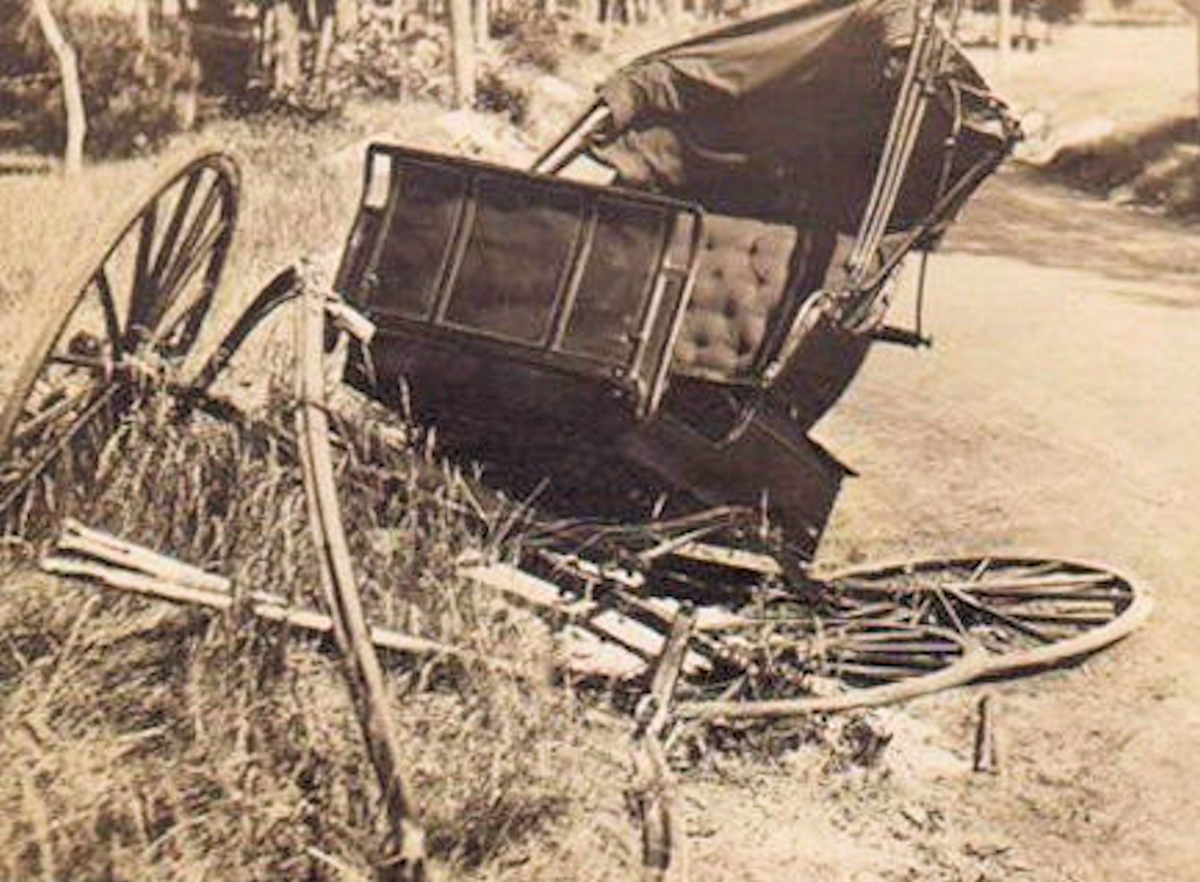
 A photograph of a RSW mishap found in
A photograph of a RSW mishap found in
the Scrapbook on our page "Car Troubles".
RELATED LINKS:

